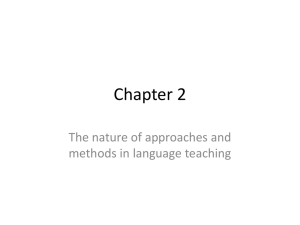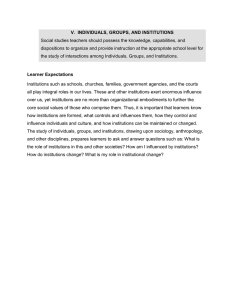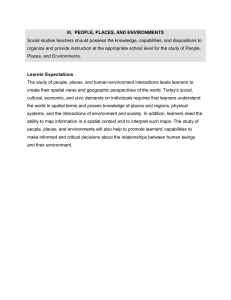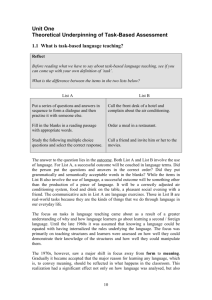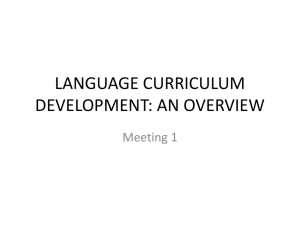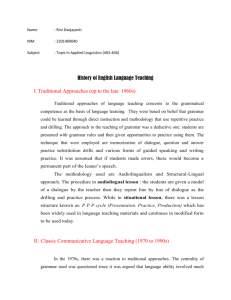Resource Evaluation Questionnaire…
advertisement
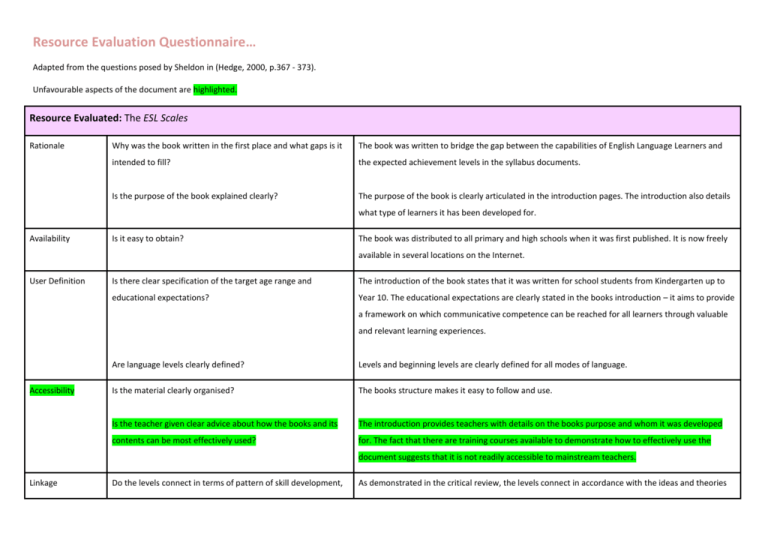
Resource Evaluation Questionnaire… Adapted from the questions posed by Sheldon in (Hedge, 2000, p.367 - 373). Unfavourable aspects of the document are highlighted. Resource Evaluated: The ESL Scales Rationale Why was the book written in the first place and what gaps is it The book was written to bridge the gap between the capabilities of English Language Learners and intended to fill? the expected achievement levels in the syllabus documents. Is the purpose of the book explained clearly? The purpose of the book is clearly articulated in the introduction pages. The introduction also details what type of learners it has been developed for. Availability Is it easy to obtain? The book was distributed to all primary and high schools when it was first published. It is now freely available in several locations on the Internet. User Definition Is there clear specification of the target age range and The introduction of the book states that it was written for school students from Kindergarten up to educational expectations? Year 10. The educational expectations are clearly stated in the books introduction – it aims to provide a framework on which communicative competence can be reached for all learners through valuable and relevant learning experiences. Accessibility Are language levels clearly defined? Levels and beginning levels are clearly defined for all modes of language. Is the material clearly organised? The books structure makes it easy to follow and use. Is the teacher given clear advice about how the books and its The introduction provides teachers with details on the books purpose and whom it was developed contents can be most effectively used? for. The fact that there are training courses available to demonstrate how to effectively use the document suggests that it is not readily accessible to mainstream teachers. Linkage Do the levels connect in terms of pattern of skill development, As demonstrated in the critical review, the levels connect in accordance with the ideas and theories grammatical/ lexical progression, etc? of SLA. Does the text connect to other education texts? The text connects with other mandatory documents such as syllabus documents and the Literacy Continuum. Authenticity Do the tasks exploit language in a communicative manner? The book is underpinned by the theory of communicative language and encourages the learning of English through real-life experiences. Sufficiency Is the book complete enough to stand on its own? This book cannot stand alone to guide the teaching of students in mainstream school settings. Cultural bias Are different cultures valued and catered for? Different cultures are valued in the book. The text encourages teachers to allow students to use their first language during classroom learning experiences and share stories about their culture. Education Validity Is the book in tune with broader educational concerns? The book was developed by a group of language and linguistic specialists over the course of two years it was developed specifically to supplement existing syllabus documents. Flexibility Can the book accommodate the practical constraints of the The books allows for great flexibility due to the fact that it is a framework upon which programs and context? curriculum can be developed in accordance with syllabus document specifications. This means that teachers can program and plan according to the expectations and time constraints of a particular context. Does the book make too many demands on teacher’s Mainstream teachers do not need to develop extra standalone teaching programs when using this preparation time? document. Rather it is to be used when writing their class programs to ensure that the curriculum they teach caters to the needs of language learners. Overall Value for Is the book cost effective? The book was free when it was first distributed and it can be accessed free of charge online. To what extent has it realised its stated purpose? The book is easy to use and it achieves the purpose stated in the introduction. Money?
